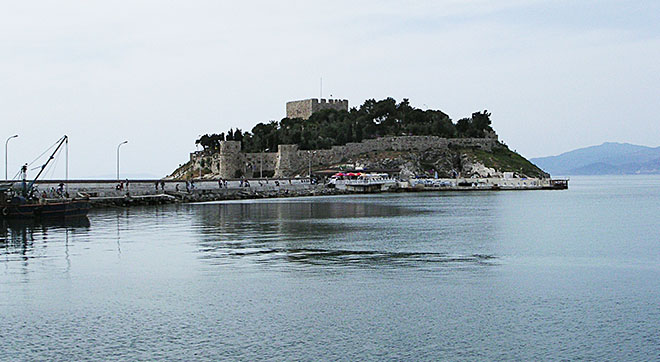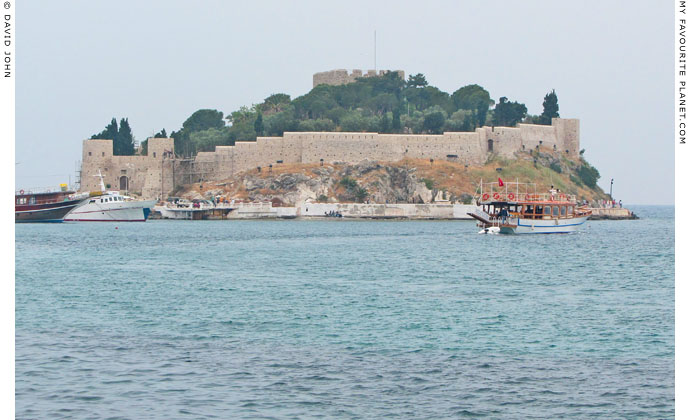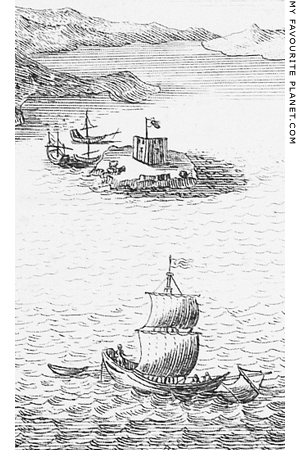|
|
|
| My Favourite Planet > English > Middle East > Turkey > Kuşadası > photo gallery |
| Kuşadası, Turkey |
Kuşadası photo gallery |
 |
 |
1 of 14 |
 |
 |
|
| |

Güvercinada Kalesi, the fortress on Güvercin Ada (Pigeon Island),
joined to the mainland by a 350 metre long causeway. |
The name Kuşadası means bird island (kuş = bird and adası = island). You may be told that this is due to the fact that the bay's headland resembles a bird's head when seen from the sea. Personally, I don't get this. Perhaps this was once true, but it is difficult to see the resemblance today. I keep looking at maps and photos trying to imagine it.
Another theory concerning the name is based on the remark by the 17th century Ottoman traveller Evliya Çelebi (1611-1682), who reported that it was visited every year by a great number of birds. [1]
Even more confusing is that the fortified island (or islet) to the south of the town's harbour is actually called Güvercin Ada which means Pigeon Island (or Dove Island). And the island is technically not even an island. A causeway was built to it in the 19th century [2], as part of the refortifications during the Greek War of Independence, turning the islet effectively into a headland. The 350 metre long causeway is now a pretty solid structure, along which fishing and excursion boats moor and local anglers catch their evening meal.
The fortress on the island is thought to have been originally built by the Genoese who established a trading settlement here, known as Scala Nuova, in the 13th century. The fortifications were improved and extended by the Ottomans during the 15th - 19th centuries (see below).
Today the island is part historical monument, part public park, and has recently been renovated (see below). You can swim from the rocky island shore (although you may prefer one of the local beaches) and the views of the Ionian coast to the south, along Kuşadası's waterfront to the north and over to Samos in the west are quite beautiful. |
|
| |
| |

Güvercinada Kalesi during renovation work in 2013. In the foreground, right,
is one of the boats which take tourists on day tours and to nearby beaches.
|
Little is known about the history of Kuşadası, since there are very few historical documents relating to the town, and hardly any archaeological investigation has been undertaken there (see History of Kuşadası). It may have been populated in ancient times, but is first known as a port from the 13th century when it became a Genoese colony known as Scala Nuova. There may have been a Byzantine or Genoese fortress on Güvercin Ada at this time.
For many years the castle was generally referred to as "the Genoese fortress", however in recent years, with the greater emphasis in information provided by official publications and websites on Ottoman Turkish heritage, this name now seems to have been dropped. It is now referred to as Güvercinada Kalesi (Güvercinada Castle) or Kuşadasι Kale (Kuşadasι Castle).
The round-arched gateway is at the southeast corner of the outer walls, just to the south of the east end of the causeway from the mainland. It is flanked by a cylindrical tower to the south and a polygonal tower to the north. A hallway within the gate leads up to the large open courtyard around the much taller central tower, which stands south of the centre of the island. The tower is almost square in plan, measuring 15.5 x 17.5 metres.
It is currently thought that the square tower was commissioned by the Ottoman admiral Barbaros Hayreddin Paşa (circa 1478 - 1546) [3]. An engraving published by Joseph Pitton de Tournefort, who visited Kuşadası in 1702, and a drawing made there in 1777 by Johann Christian Kamsetzer, show the tower standing on a bare island, without surrounding walls. Evliya Çelebi, who visited in 1671 [see note 1], reported that the tower was manned by forty soldiers and armed with ten long-range cannons. Tournefort wrote that "they have built a square castle, where they keep a garrison of twenty soldiers".
An inscription high on the outer wall of the castle, to the right of the gateway, dated 1242 AH (the Islamic date; 1826 AD), states that the outer walls were built by İlyas Ağa, a local governor, with stone from nearby Yılancı Burnu.
Directly above the gateway is a shallow niche in which another inscription is thought to have once stood. The niche is now occupied by a modern inscription recording the recent renovation of the castle, 2012-2015. |
|

An engraving of Güvercinada Castle
as it appeared in 1702.
From Joseph Pitton de Tournefort,
Relation d'un voyage du Levant, 1717.
See the whole engraving and details
on the History of Kuşadası page. |
|
| |

One of the towers of the Genoese fortress on Güvercin Ada during renovation work in 2013.
|
The castle appears to have been abandoned during the 20th century and remained for many years in a semi-derelict condition. Gradually several temporary buildings were erected within the walls for use as a restaurant and a disco. There were also several trees, a flower garden, an enclosure containing rabbits as well as bird houses on tall metal poles for the innumerable pigeons and doves (see gallery page 7).
These amenities were all a bit makeshift and low-rent, adding to the old-and-crumbling charm of the castle itself, but the place was very popular in the summer, particularly with Turkish families. When I was there in 2004 I was informed that the place was run by the municipality, but recent reports refer to them as "illegal buildings". They were obviously too "down-market", and since the local authorities and businesses have been attempting to improve the town's image and attract a wealthier class of tourists, they had to go.
A plan was drawn up in 2010 to renovate the castle and it was closed to the public. The modern buildings were demolished and the inside of the castle cleared, the walls were given a complete makeover, and finally the grounds were landscaped. It was officially reopened in September 2016. |
|
|
| |
Kuşadası
Turkey |
Notes, references and links |
|
 |
|
1. Evliya Çelebi on Kuşadası
Derviş Mehmed Zillî (1611-1682), known as Evliya Çelebi (his pen name), made a number of journeys around the Ottoman Empire, neighbouring lands and Europe over forty years, and recorded his travels in the ten-volume Seyahatname (Book of travel). He visited Kuşadası in 1671 during his pilgrimage to Mecca, recorded in volume 9.
No English translation of the whole work has yet been published. According to the few attempts to translate the passage conerning Kuşadası, Çelebi wrote that it was so named because "a hundred thousand birds" or "hundreds of thousands of birds" visited the island of Güvercin Ada every year. This is usually taken to refer to some type or types of migratory birds. Turkey's Central Aegean coast is on the migration paths of several bird species (see Ionian Spring Part 3 at The Cheshire Cat Blog), although none of them stop off at Kuşadası in large numbers today.
See: Evliya Çelebi, Seyahatnamesi, Volume 9 (dokuzuncu cilt), pages 144-146. Devlet Matbaasi, Istanbul, 1935. In Turkish at the Internet Archive.
2. The causeway to Güvercin Ada
I can no longer find the source of information concerning the causeway's construction in the 19th century. The new information board on the island states that the causeway was built in the 1960s, but this may have been when it was renovated and enlarged.
3. Barbaros Hayreddin Paşa and Kuşadası
Several recent publications state that Barbaros Hayreddin Paşa built or commissioned the castle "according to some sources", although the sources are not provided.
It has also been stated that the outer walls were built because of fear of attack from the islands during the Greek Orlov Revolt of 1770-1771, during the Russo-Turkish War (1768-1774). Again sources for this information are not usually cited. The 1777 drawing by Kamsetzer shows that no walls had been built around the island by this time, although the central tower may have been modified. If the walls were built in 1826, then it was during the Greek War of Independence (1821-1829). |
|
|
Map, photos and articles: © David John,
except where otherwise specified.
Additional photos: © Konstanze Gundudis
All photos and articles are copyright protected.
Images and materials by other authors
have been attributed where applicable.
Please do not use these photos or articles without permission.
If you are interested in using any of the photos for your website,
project or publication, please get in contact.
Higher resolution versions are available on request.
Some of the information and photos in this guide to Kuşadası
originally appeared in 2004 on davidjohnberlin.de. |
|
| |
 |
Visit the My Favourite Planet Group on Facebook.
Join the group, write a message or comment,
post photos and videos, start a discussion... |
|
|
| |
|
|
|